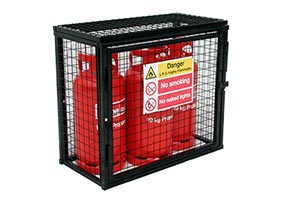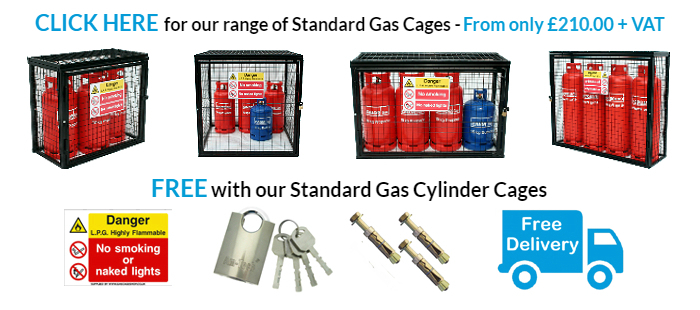GasGrab™ Gas Cylinder Handles
GasGrab™'s unique patented scissor action clamps around the body of the cylinder allowing the operator to safely lift or move it a short distance.

From only £89.95
Standard Gas Cylinder Cages
Our all new range of static cages now include high security hinges and fixings.

From only £210


Gas Cylinder Storage Guidelines
The following links provide regulatory information relating to the storage of gas cylinders:
- HSE - Drum and Cylinder Handling Guidelines
- BCGA - The Storage of Gas Cylinders - Code of Practice 44
- UKLPG - Storage of Full and Empty LPG Cylinders and Cartridges - Code of Practice No. 7
- NERC - Guidance to Safe Storage and Installation of Gas Cylinders
- CALOR - How to Safely Store Gas Bottles
- CALOR - Code of Guidance for the Storage of Cylinders
- CALOR - Cylinder Storage Information
Please see our full range of Standard Gas Cylinder Storage Cages for your gas cylinder storage requirements. From only £210.00 + VAT (delivered).
The following information covers some major requirements for the storage of compressed gases.
- Store all cylinders in designated areas that are secured.
- Flammable, toxic and Oxygen (or any Oxidizer) shall be separated from each other by a distance of at least 3 meters, or by a non-combustible barrier at least 1.5 meters high with a fire resistance rating of at least 30 minutes. Inert gases (Argon, Nitrogen, Helium, Carbon Dioxide), since they are chemically inert and compatible with all other gases, may be used within the separation distance.
- Outdoor storage shall be kept clear of dry vegetation and combustible materials for a minimum distance of 4.5 meters.
- Cylinders stored outside shall not be placed on the ground (earth) or on surfaces where water can accumulate.
- Storage areas shall be provided with physical protection from vehicle damage.
- Do not store cylinders near elevators, loading platforms, gangways, or under operating cranes, or other areas where they can be damaged by falling objects.
- Cylinders shall not be exposed to temperatures in excess of 125F.
- Smoking and open flames shall not be permitted in Oxygen and flammable gas storage areas or within 6 meters of such areas.
Small Storage / Display (up to 70kg):
- Any cylinders of any size stored on a commercial premises with public access should be secured in a lockable cage, cabinet or enclosure.
- No more than five cylinders should be allowed on a retail display with total contents no more than 70kg.
- Single cylinders larger than 20kg should not be displayed in shops.
- If the shop is below residential premises then no more than 15kg should be stored/ displayed.
- No more than four bottles should be connected for demonstrating at any one time (total weight no more than 50kg).
- Do not display on staircases, near emergency exits or near to flammable materials.
- Bottles must be treated as FULL unless they are dummy bottles or have been certified as gas free. Only five cylinders are allowed - even if some of them are empty.
Storage up to 400KG:
The storage area should be at least 1m from a site boundary, building etc. unless a fire wall is provided.
- Only vehicles delivering LPG should be allowed within 1m of the storage area.
- No opening into buildings, cellars or pits should be within 2m of an LPG storage area.
- No flammable liquids, combustible, corrosive or oxidising material should be stored within 3m of an LPG store. Compressed oxygen must be kept 10m away from all flammable gases; these include propane, butane and dissolved acetylene.
- The area should be kept clear of weeds and rubbish.
- The storage of LPG should not hinder or endanger the means of escape from the premises.
- The extent of the storage area should be clearly marked and suitable notices displayed prominently.
- Appropriate steps should be taken to prevent tampering and vandalism. In many cases it may be appropriate to enclose the storage area in a lockable cage.
- The same restrictions apply to empty cylinders as to full ones.
Storage above 400KG:
For larger storage, other safety requirements exist, including the maintenance of a minimum separation distance between bottle storage and any boundary, building or fixed source of ignition. This is determined by the total amount of LPG stored and the size of the largest stack of bottles - whichever gives the greatest distance. In certain circumstances this separation distance may be reduced by the use of a radiation wall.
For further information on cylinder storage please consult the LPGA Code of Practice no.7.
If in doubt please contact your local HSE Office for further guidance: www.hse.gov.uk/contact
PLEASE NOTE: This page is for information purposes only. We strongly recommend you contact your local HSE Office for further, specific information on how to conform to UK gas cylinder storage guidelines.





